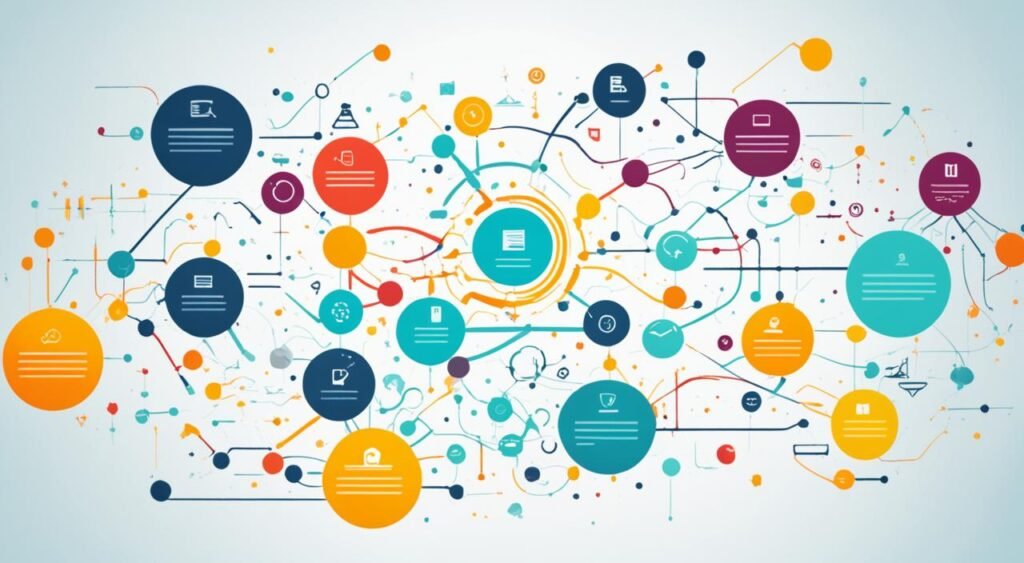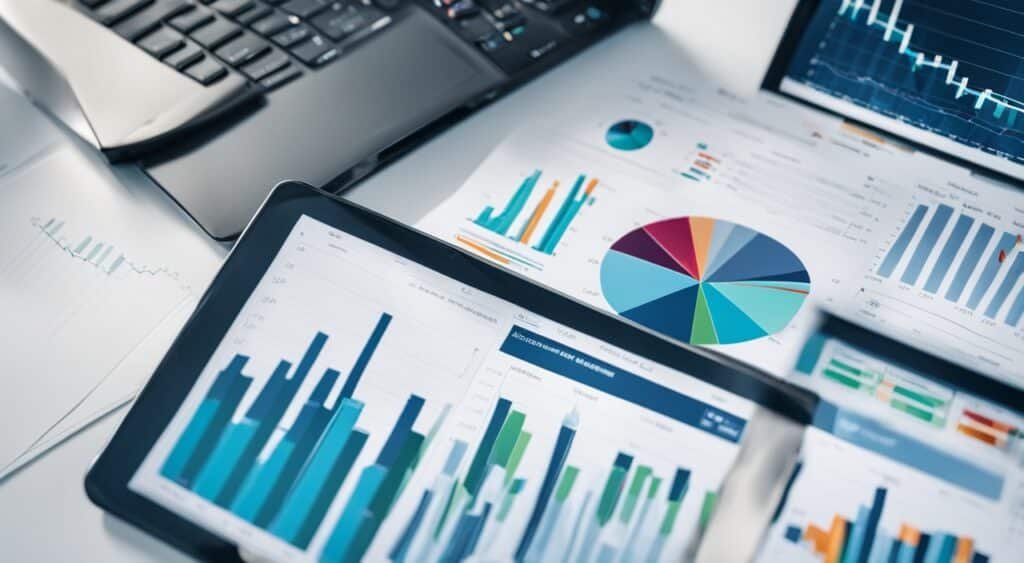Business intelligence (BI) turns raw data into useful insights for companies. It uses data analysis to help businesses see the big picture. By gathering and analyzing data, BI makes it easier to guide decisions and improve how a company runs.
BI provides the facts and figures needed for better decisions. It uses reports and visual data to offer clear insights, making choices smarter. This approach helps businesses stand out from the competition. It also improves how companies run and how they serve their customers.
Key Takeaways
- Business intelligence is a data analytics discipline that transforms raw data into actionable insights.
- BI helps businesses make better-informed, data-driven decisions to enhance strategy, efficiency, and goal achievement.
- Key BI processes include data gathering, analysis, and visual presentation through reporting, metrics, and analytics.
- BI empowers organizations to gain a competitive edge, optimize operations, and improve the customer experience.
- Implementing a comprehensive BI strategy is crucial for data-centric decision-making and overall business success.
Defining Business Intelligence
Business intelligence (BI) is a key part of data analytics. It involves collecting, analyzing, and showing data strategically. BI’s main goal is to help businesses make better decisions by turning complex data into simple insights.
The Core Aspects of Business Intelligence
Business intelligence has three main elements. They are data gathering, analysis, and visualization. Each step plays a vital role in helping companies understand their data better.
- Data Gathering – BI systems grab data from many places. This includes inside the company, from the market, and from customer interactions.
- Data Analysis – BI uses tools to find patterns and insights in data.
- Data Visualization – After analysis, data is shown visually. This can be in charts or dashboards. It helps in making clear decisions.
When these steps work together, business intelligence lets companies deepen their knowledge. They can better understand their operations, customers, and markets. This understanding helps them make smarter decisions.
“Business intelligence is the ability to transform data into information, and information into knowledge.”
– Howard Dresner, Gartner
The strength of BI lies in its data analytics and data visualization. These tools help track performance, find chances, and predict trends. In the end, it supports better decision-making and steady company growth.
How Business Intelligence Works

Business intelligence (BI) is a game-changer for companies. It turns raw data into helpful insights. This helps organizations make smart choices. The heart of BI is a methodical path. It involves collecting, analyzing, and using data to answer big questions. This, in turn, helps businesses measure how well they are doing against their goals.
Collecting and Integrating Data
The journey starts by gathering data from different places, both inside and outside the company. It pulls together things like sales, what customers are doing, finances, and what’s happening in the market. Doing this right, with effective data integration, is key. It makes sure data is reliable, precise, and ready for deep analysis.
Analyzing and Visualizing Data
After the data is brought together, BI tools start to chew on it. They look for patterns and trends. Techniques like real-time analytics, stats, and digging into the data (data mining) are used. All to make the info understandable. This creates visuals, like graphs and dashboards. These visuals help leaders quickly see what’s happening and make decisions.
Driving Informed Decision-Making
The main aim of BI is to supercharge decision-making. It focuses on using data to make any decisions better. This can really beef up a company’s business strategy, the quality of data, and how well they perform. With BI’s help, companies get to know their customers better. They run things smarter and keep ahead of their rivals.
“BI is not just about crunching numbers; it’s about transforming data into a strategic asset that drives business success.” – John Doe, Chief Data Officer, XYZ Corporation
In a nutshell, getting to grips with BI means organizing, blending, analyzing, and representing data. This has a simple goal: guiding smart, growth-focused business decisions. By using BI, companies stand out and flex in today’s data-heavy world.
Business Intelligence Analysis Methods

Business intelligence (BI) is a toolbox of techniques that helps organizations turn data into insights. It covers everything from data mining to deep statistical analysis. These tools help leaders make decisions based on facts, not guesswork.
Key BI Analysis Techniques
Here are some of the main methods in BI:
- Data Mining: This finds hidden patterns and trends in large amounts of data. It helps discover new actions a business can take.
- Reporting: It creates reports and visuals to understand how well the business is doing. These tools help keep track of the business as it grows.
- Descriptive Analytics: This looks at past data to understand what has happened and what trends are key for the business.
- Querying: It allows you to ask the data questions to find the information you need for your business.
- Statistical Analysis: This uses math to find important patterns in the data that can guide business decisions.
- Data Visualization: It turns numbers and facts into easy-to-understand charts and graphs. This helps everyone in the business see the big picture.
- Data Preparation: This step makes sure raw data is cleaned up and ready for analysis. It sets the stage for accurate insights.
Together, these techniques build a strong foundation for powerful businessanalytics. They allow companies to get real value from their data.
“The goal of business intelligence is to enable better, faster, more informed business decisions.”
By using these tools, companies can make their data work for them. This leads to better results, happier customers, and a stronger position in the market.
Difference Between BI, Data Analytics, and Business Analytics

When we talk about making decisions with data, it’s key to know the roles of business intelligence (BI), data analytics, and business analytics. They are not the same thing, though people use these terms like they are. Each has its own key points.
Business Intelligence (BI) includes the tools and methods to gather, look at, and show data. This helps make smart business choices. BI focuses on showing real-time data, using dashboards, and doing analysis whenever it’s needed. This gives a full picture of how well a company is doing.
Data Analytics looks into data to find patterns and insights. It uses math and computer tools to understand info hidden in the numbers. Companies turn to data analytics to solve problems, guess what comes next, and get better at what they do.
Then, we have Business Analytics. This is a part of data analytics that aims to support big decisions in a company. By using models, predictions, and ways to show data, it helps companies see their current status. This way, they can spot ways to get better and make smart choices for the future.
Although BI, data analytics, and business analytics are related, they do different jobs. BI looks at general business performance. Data analytics dives deeper with its analysis. And business analytics guides the big decisions by using data wisely.
By using the best of all three methods, companies can lead with data. This helps them make better choices, run smoother, and do well overall.
Traditional vs Modern Business Intelligence

The business intelligence (BI) field has changed a lot. It has moved from a top-down, IT-focused way to a self-service model. This change is due to the need for quick, smart choices in a fast and data-heavy world.
The Traditional BI Approach
In the old days, BI was all about IT and data experts. They’d pull data from many places, work on it, and create reports. This process was slow and often led to decisions based on old info.
The Rise of Modern BI
Today, modernbi is all about selfserviceanalytics and getting insights quickly. Anyone in a business can now look at data on their own, without IT’s constant help. This lets firms make better, faster decisions, boosting how well they do and staying ahead.
- Self-service analytics: Anyone in a business can dive into data using easy BI tools, even if they’re not tech experts. This helps spot new ideas and make choices.
- Speed to insight: Modern BI lets companies find out things and react quicker, which is key in a fast-moving market.
Cloud-based BI tech has played a big part in this change. It’s made advanced analysis easier and more doable for businesses big and small.
“Moving to modern business intelligence has really changed the game. It lets our team make quick choices based on solid data like never before.”
With today’s tough business world, turning to modernbi is key to keep growing and outshine others.
Key Benefits of Business Intelligence

Business intelligence (BI) is a big help for companies of all types. It uses data to bring dataclarityj, increase efficiency, make customerexperience better, and raise employeesatisfaction. Let’s look closer at these big pluses.
Data Clarity and Informed Decision-Making
BI makes complex data easy to understand. It uses tools like interactive dashboards to turn data into clear pictures. These visuals show trends and metrics to help companies make smart choices.
Increased Operational Efficiency
BI boosts efficiency by making data processes automatic. It finds ways to do things better and smoother. This cuts costs, ups productivity, and makes a company more agile.
Enhanced Customer Experience
BI dives deep into what customers like or need. It lets companies customize their service, guess customer desires, and offer better experiences. This leads to happier customers.
Improved Employee Satisfaction
BI also makes employeesatisfaction grow. It gives workers data and tools so they can do their job better. With the right info at their fingertips, employees are happier, work better, and make smarter decisions.
Overall, BI’s benefits include clearer dataclarityj, higher efficiency, improved customerexperience, and happier employeesatisfaction. Using BI well can make your business stand out, be more innovative, and grow strong over time.
Real-World Examples of Business Intelligence

Business intelligence (BI) helps companies make smart decisions and beat their rivals. It’s used in healthcare, retail, and more to gather, look at, and use data. This makes their work better, makes customers happier, and keeps them in the lead.
Optimizing Retail Operations with BI
Take Walmart, for example. It uses big data from customers to know what they want. This way, they need less stock and can make shopping feel more personal. Walmart’s use of BI has made its supply chain smoother, cut waste, and improved how it all runs.
Enhancing Patient Care through BI in Healthcare
In healthcare, BI changes how care is given. Places like Mayo Clinic use BI to see the results of treatments, spot those at high risk, and use resources better. This makes decisions smarter, effects better, and gives patients better care.
Driving Personalization with BI in Banking
Even banks, like Chase, are into BI. They check how customers act with their money, see the trends, and offer products or ads that fit each person. This not only makes folks happier but also helps the bank earn more money.
| Industry | BI Application | Benefits |
|---|---|---|
| Retail | Demand forecasting, inventory optimization, personalized customer experiences | Improved operational efficiency, reduced waste, enhanced customer satisfaction |
| Healthcare | Clinical outcome tracking, high-risk patient identification, resource optimization | Improved patient care, better resource allocation, streamlined operations |
| Banking | Customer behavior analysis, personalized product offerings, targeted marketing | Increased customer satisfaction, improved revenue opportunities, competitive advantage |
The different uses of BI show how flexible and powerful it is. It brings real changes in strategy, case studies, and daily work in many fields. Turning data into plans makes businesses better, keeps customers happy, and makes winning a regular thing.
“Business intelligence is not about the data. It’s about the insights that data can provide to drive better business decisions.”
Developing a BI Strategy

Creating a strong bistrategy is key for businesses looking to use business intelligence (BI). This strategy involves clear steps for biimplementation and smart decisions based on data. We’ll look at the important parts of developing a good BI strategy.
Define Your Business Goals
First, you need to set your businessgoals clearly. Do you want to make things run smoother, make customers happier, or stand out from the competition? Aligning your BI work with your business goals ensures your bitools and datainfrastructure will give you the insights you need.
Identify Key Stakeholders
Having the right people involved is crucial for successful BI. Find the main decision-makers, data experts, and users. Knowing what they need and think helps make a BI strategy that meets everyone’s needs.
Assess Your Data Landscape
It’s vital to check your dataquality and datainfrastructure before using BI tools. Figure out where your data comes from, what issues it has, and any missing parts. This check will guide your choice of tools, how you link your data, and how you ensure its quality.
Develop a Comprehensive Roadmap
With your goals, people, and data needs clear, make a detailed roadmap for your BI. This plan should spell out what to do, when to do it, and what you’ll need. A solid roadmap helps you roll out BI smoothly across your business.
Building a strong BI strategy is essential for making the most of data and smart decisions. By focusing on these core elements, companies can match their BI work with their major goals, involve the right people, and create good datainfrastructure for their biimplementation.
Categories of Business Intelligence Analysis

In the businessintelligence and dataanalytics world, businesses have several analysis categories to get valuable insights. These techniques help organizations make better decisions and enhance their performance.
Descriptive analytics is the first major type. It looks at past data to find trends and give a current business overview. This type helps create reports and visuals. They make it easier for leaders to see how the business is doing and how to get better.
Diagnostic analytics is another key type. It asks why certain results happened. By digging into causes, it helps companies fix the real problems.
- Predictive analytics, using stats and learning algorithms, predicts future events from past data. This lets businesses prepare for what’s coming.
- Prescriptive analytics, the last type, offers advice from data insights. It guides businesses to make better decisions for success.
Then, there’s cognitive analytics. It uses advanced tech to find hidden patterns. This gives a better understanding to make smarter, strategic choices.
| Category | Description | Key Benefits |
|---|---|---|
| Descriptive Analytics | Analyzes historical data to understand what has happened in the past | Provides a clear picture of current business performance, identifies patterns and trends |
| Diagnostic Analytics | Focuses on understanding why certain events or outcomes have occurred | Helps identify and address the root causes of problems |
| Predictive Analytics | Uses statistical models and machine learning to forecast future events and outcomes | Enables businesses to anticipate and prepare for potential opportunities and challenges |
| Prescriptive Analytics | Provides recommendations and suggested actions based on insights derived from analysis | Supports data-driven decision-making and improved outcomes |
| Cognitive Analytics | Leverages advanced technologies like natural language processing and AI to uncover hidden insights | Provides a deeper understanding of operations, customers, and markets |
By using and understanding these analysis types, businesses get a complete view. They can make better decisions for growth and success.
Also Read : Effective Business Management Strategies & Tips
Business Intelligence Implementation

Implementing business intelligence (BI) helps organizations use data-driven decisions. It lets them stay ahead, work better, know more about customers, and predict the future. This way, businesses can find new chances and grow strong over time.
Empowering Data-Driven Decision Making
BI turns raw data into insights for important business choices. With BI, you can use tools to see data visually. You can find important patterns and opportunities in a sea of information.
Gaining a Competitive Advantage
BI can give companies a competitive edge. It shows new market areas and what customers really want. With this knowledge, businesses can lead the way and react quickly to changes.
Improving Operational Efficiency
BI makes operations smoother by finding and fixing issues. It also helps in better use of resources. Monitoring performance in real time and using predictive analytics helps businesses save money and work better.
Enhancing Customer Insights
BI offers deep looks into customer needs and behavior. This lets companies offer more personalized services. It builds stronger, more profitable ties with customers.
Enabling Predictive Analysis and Real-Time Reporting
BI’s predictive analytics help spot trends and anticipate customer needs. Real-time reporting gives instant insights. This lets businesses grasp new market chances quickly.
Adopting BI brings many benefits, like smarter choices and focusing more on customers. As the market changes, BI will be key to staying ahead and succeeding long term.
Conclusion
Business intelligence (BI) offers a big advantage to companies today. It provides key insights by analyzing data. This helps businesses of all sizes make smarter choices.
Today, self-service analytics and real-time reports are crucial. They allow everyone in a company to use data for decision-making. This change has improved how companies solve problems and interact with customers.
Having a strong BI strategy is more important than ever. It lets companies stand out in a world driven by data. By using BI and data analytics, companies can innovate and lead in their fields.
FAQs
What is business intelligence and why is it important for businesses?
Business intelligence (BI) is about using data to understand and improve a business. It gathers and analyzes information. Then, it shows this data in a way that’s easy to see and use. This helps companies make choices that help them grow. By using BI, businesses improve their strategies, how they work, and meet their goals.
What is the definition of business intelligence?
Business intelligence (BI) is a part of data analytics. It means collecting, analyzing, and showing data in visual ways. The main goal of BI is to help businesses make better choices by understanding information more clearly.
How does business intelligence work?
Companies collect data about their business. Then, they analyze this data to find insights. They use these insights to answer questions and understand how well they are meeting their goals. BI systems help turn this data into easy-to-understand charts and graphs.
What are the business intelligence analysis methods?
BI includes many steps like data mining, reporting, and statistical analysis. It looks at how a business performs and uses this information to make smart decisions. Businesses use tools to show this data in clear ways, like through charts.
What is the difference between BI, data analytics, and business analytics?
Business intelligence (BI) is a part of data analytics. It focuses on making businesses’ decisions better. Business analytics is wider and looks at using data for all parts of a business’s operation.
What are the differences between traditional and modern business intelligence?
Modern BI is all about being quick and letting people within a business find their own answers. Before, traditional BI was managed by a few people and used older tools. This meant it was slower and less flexible.
What are the key benefits of business intelligence?
BI brings a lot of good things to a business. It makes data clear, improves how the business works, and makes customers and employees happier.
Can you provide some real-world examples of business intelligence?
BI is everywhere. It’s used to shape business plans, make things run smoother, and understand what customers want. It’s all about using facts to guide decisions.
How do you develop a business intelligence strategy?
Creating a BI strategy involves setting goals and picking the right tools. You also need to choose a team to manage it and create a plan for how to use data. This guides your business towards its goals.
What are the different categories of business intelligence analysis?
BI analysis has many parts, from showing data in useful ways to predicting what might happen next. It covers a wide range of tools and skills.
How is business intelligence implemented?
Implementing BI means using data to make decisions. It gives businesses an edge by understanding their data better. This leads to smarter choices, better customer service, and being more prepared for the future.
